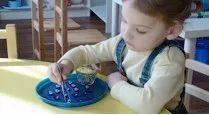Maria Montessori on Liberty and Discipline
Liberty and discipline are closely related concepts. You may wonder how this can be. Most people think that when a child needs discipline you take away his freedoms, right? Parents sometimes do this: “You knocked over this vase! I want you to clean it up, and then you can go to your room and think about how careless you are.” Schools also do this: “You are late getting this paper in. You can stay in from recess to get it done.”
Sometimes there is a valid logic to the situation, where the consequences are appropriate for the infraction. But there is another way to look at it when we are considering the lives and behavior of children.
Maria Montessori wrote that, for children, liberty and discipline are two sides of the same coin; if there is a lack of discipline, somewhere there is a lack of liberty. When we use the word “discipline” in the Montessori way, we are speaking about self-discipline. Let’s look at this from the perspective of a three-year-old. The child has a strong developmental need to coordinate his movements. He wants to strengthen his balance and the curb looks really inviting as a means to test out that balance. He wants to walk on the edge. He needs to walk on the edge of something!
But, of course, there is the element of safety. It is dangerous to walk on the edge of the curb on a busy street, so Mama tells him “no.” He does not have the liberty to put himself in danger. He may cry and scream, but Mama made the right decision. She could not give him liberty just then; his response is crying and sulking.
What is Mama to do? She might observe that the child is interested in walking on  the curb. If she knows a bit about child development, she will understand this need for coordination of activity. She might suggest he walk on the lines in the middle of the sidewalk. She might tease him, “Don’t step off that line!” She might have Daddy build a balance beam in the back yard.
the curb. If she knows a bit about child development, she will understand this need for coordination of activity. She might suggest he walk on the lines in the middle of the sidewalk. She might tease him, “Don’t step off that line!” She might have Daddy build a balance beam in the back yard.

In our Montessori classrooms we have an ellipse, a line on the floor for children to walk on. There they walk, run, dance, and do all kinds of activities to music. The need for coordination is met, and there is contentment and self-discipline. For this little girl, what her feet are doing is her number one concern. She has the freedom to move and she is showing self-discipline.
Let’s look at another scenar io of a child who is interested in refining the motion of her hand. She is ready to develop what we call the pincer grip, which she will use to hold a pencil and write. This little girl, almost four, has found just what she needs to satisfy her inner need to coordinate the pincer grip. She is calm, centered, and completely self-disciplined.
io of a child who is interested in refining the motion of her hand. She is ready to develop what we call the pincer grip, which she will use to hold a pencil and write. This little girl, almost four, has found just what she needs to satisfy her inner need to coordinate the pincer grip. She is calm, centered, and completely self-disciplined.

This next child, of the same age, has the same need to coordinate the pincer grip. He was just told by his mother that he could not touch the items he eagerly sought to handle to meet that need. His lack of discipline is directly related to the fact that he did not have the liberty to do what he needed to do for his internal development. Many tantrums in early childhood can be traced directly to the absence of some activity the child needs to fulfill some aspect of his development.
His lack of discipline is directly related to the fact that he did not have the liberty to do what he needed to do for his internal development. Many tantrums in early childhood can be traced directly to the absence of some activity the child needs to fulfill some aspect of his development.

The most effective way to offer the maximum liberty to the developing child and to see the maximum self-discipline is to understand the child’s developmental needs, and prepare an environment rich with activities to meet those needs. This is what Montessori schools are all about. This is what Montessori homes provide.
The more the environment meets the needs of the child and the more liberty the child is given to select his work, the more self-discipline you will see. You will understand more clearly how these two seeming opposites are actually two sides of the same coin.
Learn more about liberty and discipline in our Age of Montessori parent and teacher training course!






















